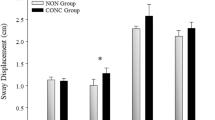Abstract
Background
Pusher syndrome is a disorder of postural control observed in patients with right or left brain damage associated with hemiparesis. Those patients show a peculiar behavior of actively pushing away from the nonhemiparetic side and resisting against passive correction, with a tendency to fall toward the paralyzed side. Thus far this phenomenon has been exclusively associated with stroke patients.
Objective
We investigate the occurrence, imaging features and clinical evolution of pusher behavior in patients with acute encephalic lesions at a tertiary emergency hospital.
Methods
Pusher patients were identified from 530 inpatients during a 1 year period. Patients were evaluated using a standardized Scale for Contraversive Pushing (SCP), neurological examination, assessment of neuropsychological symptoms, activities of daily living function and neuroimaging studies.
Results
We found eight patients (1.5%) with severe contraversive pushing, three female and five male. Age at symptoms onset ranged from 48 to 80 years (mean 65.4). All patients had scores equal or above 1.5 in each tested parameter of the SCP. Six patients (75 %) had right-hemisphere brain damage. A stroke etiology was found in four patients. The other four patients had non-stroke etiology (three traumatic, one metastatic tumor). Stroke patients showed complete recovery of pusher behavior at a mean duration of 15.3 weeks. In patients with brain trauma, pushing behavior was completely resolved in a mean time of 5 weeks.
Conclusions
The results demonstrate that contraversive pushing may also occur in patients with non-stroke neurological lesions and suggest that resolution of symptoms may vary according to the underlying etiology.
Similar content being viewed by others
References
Bisiach E, Vallar G, Perani D, Papagno C, Berti A (1986) Unawareness of disease following lesions of the right hemisphere: anosognosia for hemiplegia and anosognosia for hemianopia. Neuropsychologia 24:471–482
Davies PM (1985) Steps to follow: a guide to the treatment of adult hemiplegia. New York: Springer
Karnath HO, Broetz D (2003) Understanding and treating “Pusher Syndrome”. Phys Ther 83:1119–1125
Karnath HO, Ferber S, Dichgans J (2000) The origin of contraversive pushing: evidence for a second graviceptive system in humans. Neurology 55:1298–1304
Karnath HO, Ferber S, Dichgans J (2000) The neural representation of postural control in humans. Proc Natl Acad Sci U S A 97:13931–13936
Karnath HO, Brotz D, Gotz A (2001) [Clinical symptoms, origin, and therapy of the “pusher syndrome”]. Nervenarzt 72:86–92
Karnath HO, Johannsen L, Broetz D, Ferber S, Dichgans J (2002) Prognosis of contraversive pushing. J Neurol 249:1250–1253
Mahoney F, Barthel D (1965) Functional evaluation: the Barthel Index. Md State Med J 2:61–65
Pedersen PM, Wandel A, Jorgensen HS, Nakayama H, Raaschou HO, Olsen TS (1996) Ipsilateral pushing in stroke: incidence, relation to neuropsychological symptoms, and impact on rehabilitation. The Copenhagen Stroke Study. Arch Phys Med Rehabil 77:25–28
Perennou DA, Amblard B, Laassel el M, Benaim C, Herisson C, Pelissier J (2002) Understanding the pusher behavior of some stroke patients with spatial deficits: a pilot study. Arch Phys Med Rehabil 83:570–575
Author information
Authors and Affiliations
Corresponding author
Rights and permissions
About this article
Cite this article
Santos-Pontelli, T.E.G., Pontes-Neto, O.M., Colafêmina, J.F. et al. Contraversive pushing in non-stroke patients. J Neurol 251, 1324–1328 (2004). https://doi.org/10.1007/s00415-004-0532-y
Received:
Revised:
Accepted:
Issue Date:
DOI: https://doi.org/10.1007/s00415-004-0532-y




